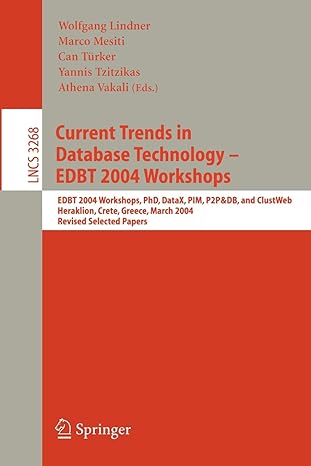Question
Question 1 5 out of 5 points An algorithm is a set of steps to solve a problem. Question 2 5 out of 5 points
Question 1
5 out of 5 points
| An algorithm is a set of steps to solve a problem. | |||||
Question 2
5 out of 5 points
| Running Time important factor in choosing an algorithm. | |||||
Question 3
5 out of 5 points
| T(N) = O(f(N)) means T(N) >= c*f(N) for N >= 0 | |||||
Question 4
5 out of 5 points
| If T1(N) = O(f(N)) and T2(N) = O(g(N)), then T1(N) + T2(N) = O(f(N) + g(N)) | |||||
Question 5
5 out of 5 points
| The choice of an algorithm matters most when the input size is small. | |||||
Question 6
0 out of 5 points
| An algorithm which repeatedly reduces a problem by a fraction in constant time is O(log(N)) | |||||
Question 7
0 out of 5 points
| A worst case running time analysis tells us the upper limit of how poor the performance can be. | |||||
Question 8
0 out of 5 points
| The stack operations push and pop can have O(1) running time | |||||
Question 9
0 out of 5 points
| If a linked list is doubly linked, it means the last node points to the first node | |||||
Question 10
0 out of 5 points
| An array supports insertion and removal of items within the list in constant time | |||||
Question 11
5 out of 5 points
| Finding a node in a linked list requires O(N) running time. | |||||
Question 12
5 out of 5 points
| Match on worst case running time | |||||||
| |||||||
Question 13
0 out of 5 points
| What is the worst case Big-O running time of the following pseudocode? for (i=0; i | |||||
Question 14
0 out of 5 points
| What is the worst case Big-O running time of the following pseudocode if list is a LinkedList? for (i=0; i | |||||
Question 15
0 out of 5 points
| What is the worst-case Big-O running time of the following pseudocode? for (i=0; i | |||||
Question 16
0 out of 5 points
| What is the worst-case Big-O running time of the following pseudocode? while (n>1) { n = n/2 print() } | |||||
Question 17
0 out of 5 points
| What is the worst-case Big-O running time of the following pseudocode? for (i=1; i<=n; i++) for (j=1; j<=n; j=i+j) print() | |||||
Question 18
5 out of 5 points
| What is the worst-case Big-O running time of the following pseudocode? T(n) = n + T(n-1) n>1 = 1 n=1 | |||||
Question 19
0 out of 5 points
| What is the worst-case Big-O running time of the following pseudocode? T(n) = 2T(n/2) + C n>1 = C n=1 | |||||
Question 20
0 out of 5 points
| What is the slowest? answer the letter of the function f = 2^N g = Nlog(N) h = N^log(N) | |||||
Step by Step Solution
There are 3 Steps involved in it
Step: 1

Get Instant Access to Expert-Tailored Solutions
See step-by-step solutions with expert insights and AI powered tools for academic success
Step: 2

Step: 3

Ace Your Homework with AI
Get the answers you need in no time with our AI-driven, step-by-step assistance
Get Started


